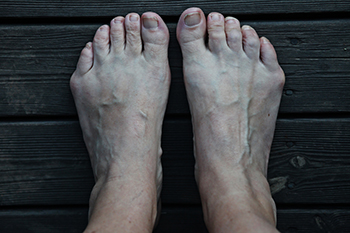
A tailor’s bunion, or bunionette, is a bony bump that forms on the foot near the base of the little toe. It occurs when the fifth metatarsal bone shifts outward, causing the joint to protrude. This condition often leads to pain, redness, and swelling especially when wearing tight shoes. Contributing factors include genetics, foot structure, and wearing ill-fitting footwear. People with flat feet or high arches are more prone to developing them. Diagnosis involves a physical exam and possibly X-rays to assess severity. Relief includes wearing wider shoes, padding the area, or using custom orthotics. Severe cases may require surgery to realign the bone. If you have a bunionette, it is suggested that you schedule an appointment with a chiropodist for appropriate relief options.
Bunions progressively worsen over time and may cause walking in your shoes to become difficult. To learn more about bunions, please consult with Paul A. Scotti, D.Ch from West Toronto Foot & Ankle Clinic Inc. . Our chiropodist will assess your condition and provide you with quality foot and ankle treatment.
What Are Bunions?
A bunion is a bony bump that protrudes from the base of the big toe. Bunions are caused due to a misalignment of the first metatarsal. The characteristic bump of a bunion forms when the metatarsal shifts outwards from its proper position. Bunions develop slowly over time and progressively worsen without treatment. The skin over the bunion may develop calluses due to the friction from shoes. Eventually, a bunion can make walking uncomfortable or even painful. Bunions are one of the most common foot deformities and are especially common in women and older adults.
Symptoms
A bunion appears as a bulging bump on the outside of the base of the big toe.
The bunion may also:
Be swollen, red, or sore
Develop corns or calluses over it
Cause pain
Limit the big toe’s range of motion
Treatment
There are several different treatments available for bunions. Conservative treatment options include wearing shoes with a wider toe box, cushioning the bunion with a specialized pad, wearing shoe inserts, icing the bunion if it becomes inflamed, and taking medications to relieve pain. In more severe cases, more invasive procedures may be done. This may involve removing the swollen tissue around the bunion, straightening the big toe, realigning the bones at the front of the foot, or a combination of these procedures.
If you have any questions, please feel free to contact our office located in . We offer the newest diagnostic and treatment technologies for all your foot care needs
